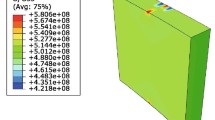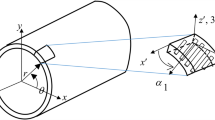Abstract
The use of composite coating is among favorite reinforcement methods for repairing cracked pressure vessels. In the present study, the effects of mechanical properties and geometry of composite coatings on Stress intensity factors (SIF) is investigated. In this regard, after verification of modeling and analytical procedure, some 3D longitudinal and transverse semi-elliptical cracks in inner and outer layer of pressure vessels are modeled in FEM software. In addition, mechanical properties and thickness are adjustable. Then SIFs in throughout of the pressurized crack face were computed. Results indicate that critical crack occurred whenever inner longitudinal crack present in composite pressure vessel. Also, via 2 mm thickness of graphite/epoxy and glass/epoxy composite coatings, 55 and 43 percent reduction in Stress intensity factors (SIF) was observed, respectively. It is shown that increasing the thickness of the composite layers reduces stress intensity factor and hence can be considered as a suitable solution for reinforcement of the cracked pressure vessel in practical situations.
Similar content being viewed by others
References
L. A. Carlsson, F. A. Donald and R. B. Pipes, Experimental characterization of advanced composite materials, CRC press (2014).
Y. S. Park and H. B. Dong, Assessment of the crack growth characteristics at the low fatigue limit of a multi-pass welded Ni-based alloy 617, Journal of Mechanical Science and Technology, 28 (4) (2014) 1251–1256.
G. H. Lee and G. B. Hyeon, Interfacial edge crack between dissimilar orthotropic thermoelastic materials under uniform heat flow, Journal of Mechanical Science and Technology, 28 (8) (2014) 3041–3050.
M.-N. Ky and Y.-J. Yum, Mode I fracture toughness analysis of a single-layer grapheme sheet, Journal of Mechanical Science and Technology, 28 (9) (2014) 3645–3652.
J. Chen and H. Pan, Stress intensity factor of semi-elliptical surface crack in a cylinder with hoop wrapped composite layer, International Journal of Pressure Vessels and Piping, 110 (2013) 77–81, doi:10.1016/j.ijpvp.2013.04.026.
A. Hocine, D. Chapelle, M. Boubakar, A. Benamar and A. Bezazi, Experimental and analytical investigation of the cylindrical part of a metallic vessel reinforced by filament winding while submitted to internal pressure, International Journal of Pressure Vessels and Piping, 86 (10) (2009) 649–655, doi:10.1016/j.ijpvp.2009.06.002.
M.-H. Gozin and A.-K. Mehrdad, Quarter elliptical crack growth using three dimensional finite element method and crack closure technique, Journal of Mechanical Science and Technology, 28 (6) (2014) 2141–2151, doi: 10.1007/s12206-014-0503-x.
G. Valentin and D. Arrat, Stress intensity factors of semielliptical cracks in single-or double-layered spherical shells, International Journal of Pressure Vessels and Piping, 48 (1) (1991) 9–20, doi:10.1016/0308-0161(91)90054-6.
S. N. Atluri and K. Kathiresan, 3D analyses of surface flaws in thick-walled reactor pressure-vessels using displacementhybrid finite element method, Nuclear Engineering and Design, 51 (2) (1979) 163–176, doi:10.1016/0029-5493(79)90088-8.
J. McGowan and M. Raymund, Stress intensity factor solutions for internal longitudinal semi-elliptical surface flaws in a cylinder under arbitrary loadings, ASTM STP, 677 (1979) 365–380, doi: 10.1520/STP34923S.
J. Mackerle, Finite elements in the analysis of pressure vessels and piping, an addendum: a bibliography (1998-2001), International Journal of Pressure Vessels and Piping, 79 (1) (2002) 1–26, doi: 10.1016/S0308-0161(01)00128-4.
B. Su and G. Bhuyan, Effect of composite wrapping on the fracture behavior of the steel-lined hoop-wrapped cylinders, International Journal of Pressure Vessels and Piping, 75 (13) (1998) 931–937, doi:10.1016/S0308-0161(98)00089-1.
A. Shahani and M. Kheirikhah, Stress intensity factor calculation of steel-lined hoop-wrapped cylinders with internal semi-elliptical circumferential crack, Engineering Fracture Mechanics, 74 (13) (2007) 2004–2013, doi:10. 1016/j.engfracmech.2006.10.014.
Y.-J. Kim et al., Elastic–plastic fracture mechanics method for finite internal axial surface cracks in cylinders, Engineering Fracture Mechanics, 71 (7) (2004) 925–944, doi:10.1016/S0013-7944(03)00159-0.
Y. Xie, An analytical method on circumferential periodic cracked pipes and shells, International Journal of Solids and Structures, 37 (37) (2000) 5189–5201, doi:10.1016/S0020-7683(99)00206-1.
J. Hu and K. Chandrashekhara, Fracture analysis of hydrogen storage composite cylinders with liner crack accounting for autofrettage effect, International Journal of Hydrogen Energy, 34 (8) (2009) 3425–3435, doi:10.1016/ j.ijhydene.2009.01.094.
P. J. Withers and H. K. D. H. Bhadeshia, Residual stress. Part 1–measurement techniques, Materials Science and Technology, 17 (4) (2001) 355–365, doi: 10.1179/02670830 1101509980.
D. Broek, Elementary engineering fracture mechanics, Springer Science & Business Media (1982).
P. O'donoghue, T. Nishioka and S. Atluri, Multiple surface cracks in pressure vessels, Engineering Fracture Mechanics, 20 (3) (1984) 545–560, doi:10.1016/0013-7944(84)90059-6.
H. Gharehbaghi, Numerical determination of stress intensity factor for welded thin aluminum cracked cylinders subjected to internal pressure and residual stress, M.Sc. Thesis, Iran University of Science and Technology, Tehran (2012) (In Persian).
J. F. Knott, Fundamentals of fracture mechanics, Gruppo Italiano Frattura (1973).
J. H. Park and P. N. Gennadiy, Growth simulation for 3D surface and through-thickness cracks using SGBEM-FEM alternating method, Journal of Mechanical Science and Technology, 25 (9) (2011) 2335–2344, doi: 10.1007/s12206-011-0528-3.
D. H. Cho et al., Enhancement of J estimation for typical nuclear pipes with a circumferential surface crack under tensile load, Journal of Mechanical Science and Technology, 24 (3) (2010) 681–686, doi: 10.1007/s12206-010-0114-0.
T. L. Anderson, Fracture mechanics: fundamentals and applications, CRC press (2005).
Author information
Authors and Affiliations
Corresponding author
Additional information
Recommended by Associate Editor Jin Weon Kim
Mahdi Fakoor is currently an assistant professor in the Faculty of New Sciences and Technologies, Department of Aerospace Engineering, University of Tehran, Tehran, Iran. His research interests include the fields of fracture mechanics and composite materials and finite element modeling.
Seyed Mohammad Navid Ghoreishi is currently a Ph.D. candidate in the Faculty of New Sciences and Technologies, Department of Aerospace Engineering, University of Tehran, Tehran, Iran. His research interests include the fields of fracture and composite analysis and finite element modeling.
Nabi Mehri Khansari is currently a Ph.D. candidate in the Faculty of New Sciences and Technologies, Department of Aerospace Engineering, University of Tehran, Tehran, Iran. His research interests include the fields of fracture and composite analysis and finite element modeling.
Rights and permissions
About this article
Cite this article
Fakoor, M., Ghoreishi, S.M.N. & Khansari, N.M. Investigation of composite coating effectiveness on stress intensity factors of cracked composite pressure vessels. J Mech Sci Technol 30, 3119–3126 (2016). https://doi.org/10.1007/s12206-016-0621-8
Received:
Revised:
Accepted:
Published:
Issue Date:
DOI: https://doi.org/10.1007/s12206-016-0621-8




